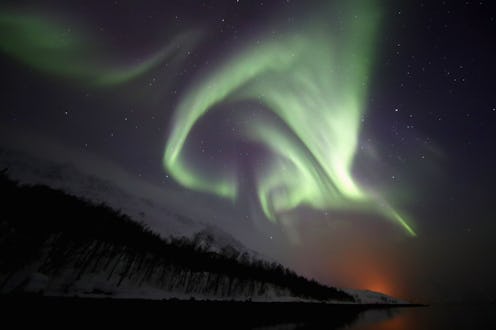Life
There’s A New Aurora Lighting Up The Sky In Canada & Researchers Named It … Steve

A few years ago, my friend's boyfriend got her an expensive pet fish, which she promptly named Steve. And though, at first, I didn't understand why she picked such a nondescript name for a rather fancy creature, I soon realized that Steve is pretty much perfect for just about anything. Why overwhelm a thing, pet, or person with complicated nomenclature, when a simple monosyllabic word will do? Plus, Steve was the best man on Sex and the City, in my humble and correct opinion. Now, researchers have named a new type of aurora "Steve," and my friend and her fish are duly vindicated.
According to a paper published this week in ScienceAdvances, the "Steve" here actually stands for "Strong Thermal Emission Velocity Enhancement," borne of a strip of hot, bright gas a group of northern lights-chasing Canadians spotted streaking the sky in souther British Columbia, Canada. Apparently, social media put Steve on the map. Per the New York Times, the light-chasers started talking about the new sighting in their Facebook group, Alberta Aurora Chasers, and brought their findings to scientists, who started wondering what was up. “The really cool thing about this is the social media providing a nice bridge between the scientific community and these amateurs, who are incredibly talented observers of the night sky,” Eric Donovan, a physics and astronomy professor at the University of Calgary, told theTimes.
So, scientists started looking into Steve, then dubbed thus after the animated film Over The Hedge ("Let's call it Steve! It’s a pretty name."). What they discovered was that though Steve lived a little farther south than his aurora borealis brethren, he's actually still a relative. Scientists think Steve is a "sub-auroral ion drift," (or SAID) which means he's a gas that shoots across the sky from east to west. Like the famed northern lights, Steve exists thanks to charged solar particles meshing with Earth's magnetic pull. But though sub-auroral ion drifts aren't new to researchers, Steve's brilliant light display differs from what scientists have seen before, hence why they spent so much time puzzling over him.
"S.A.I.D.s don’t really have any visual features, so the relationship between them and something as visually stunning as Steve is super fascinating," Alberta Aurora Chaser Chris Ratzlaff told the Times.
Initially, Ratzlaff and his crew thought Steve was a proton aurora, they told the Times, which differs from a sub-auroral ion drift, in that it's comprised of energized protons instead of energized electrons. But when a group of Aurora Chasers went to a talk at the University of Calgary last year that featured aurora borealis expert Elizabeth MacDonald, they ended up getting into a bar debate with the aforementioned Dr. Donovan, who said Steve could not possibly be a proton aurora, since humans can't actually see those.
"I said, 'Why don’t you show me?'" Donovan told the Times. "They pulled up this beautiful photograph of this thing. And I’m like, 'I don’t know what that is, but it’s not the proton aurora.'"
Donovan teamed up with satellite constellation Swarm, which collected data on Steve from space. Combined with what the aurora chasers saw on Earth, Donovan was able to start piecing Steve's life story together. Eventually, he confirmed Steve was a S.A.I.D. "It’s something that we know that’s actually been studied for 40 years,” Dr. MacDonald, whose talk at the University of Calgary sparked this whole thing, told the Times. "But they have never been seen to have this optical component."
So, the story of Steve is truly many stories. It's a story about a ragtag gang of light chasers whose Facebook group inspired a new discovery. It's a story about a scientist listening to a gang of ragtag light chasers who wanted to show him something on Facebook. And it's a story about how important it is to go to bars. Welcome to Earth, Steve.